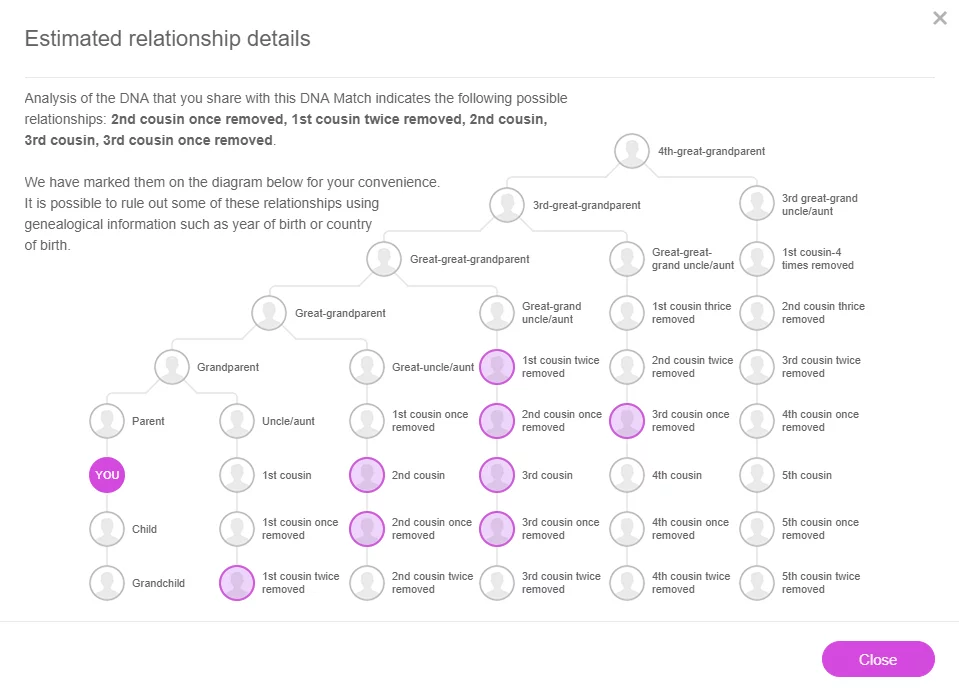
When you take a MyHeritage DNA test or upload your DNA to MyHeritage, you’ll receive both an Ethnicity Estimate and a list of DNA Matches. These are people who are likely to be relatives (close or distant) because there are significant similarities between their DNA and yours. For every DNA Match, you’ll be able to see the estimated relationship between you and the other person, based on the percentage of DNA that you share with that person.

If your match has a family tree, you’ll also be able to view it and gain more insight into how the two of you are related. We recommend contacting your top DNA Matches to exchange information about how you may be related.
Two anonymous DNA samples with 50% of their sequences in common could either be siblings or a child and parent. The first thing DNA can tell you about your known relatives is whether you are indeed related the way you think! Similarly, comparing DNA with previously unknown relatives and discovering you share significant common segments can help determine that you are related. Using various genealogical tools can help you trace how exactly you are related to your DNA Matches. Usually, there is more than one type of relationship that can be explained by the amount of shared DNA two people have in common. For example, someone who shares 25% of your DNA might be a grandparent, an aunt or uncle, a niece or nephew, or a half-sibling. By combining DNA information with other information, you can narrow down the possibilities to discover the most likely relationship. Start by looking at the individuals’ ages. If there is at least a 30-year age difference, this is more likely to be an uncle/aunt or nephew/niece relationship than a half-sibling. If there is a 60-year age difference, grandparent-grandchild is more likely. You can also look at family trees in which each person appears for more clues.
How can DNA testing tell me all this?
Human DNA is a long sequence of about 3 billion base pairs. However, 99.9% of the sequence is identical in all people. DNA tests like the MyHeritage DNA test analyze about 700,000 variable locations in the DNA sequence called SNPs. By comparing this sample of a person’s DNA sequence to reference sequences which have been read in their entirety, nearly 33 million base pairs can be inferred (or in scientific language, imputed). This sequence can now be compared to everyone else’s sequences in the DNA database to find people with significant sections in common. These people are your DNA Matches. While it’s not impossible that the shared DNA is a coincidence, it’s far more likely that two individuals who share a significant amount of DNA inherited it from a common ancestor.
Identical by descent (IBD) segments are sections of the DNA sequence that are identical in two or more people, indicating that the segment was inherited from a common ancestor and the two individuals are somehow related that through that ancestor. The larger the segment, the more recent the common ancestor — and the more likely it is that the DNA was, in fact, inherited from a common ancestor and not shared by coincidence. The larger the total amount of DNA across segments, the more closely the two people are probably related.

While close relatives share more DNA, more distant relatives share less DNA. Two distant cousins who have never met but have a common ancestor will likely have a small piece of DNA inherited from that ancestor. That’s the basis for using DNA tests to discover relatives you otherwise wouldn’t know about.
Exactly how small a short sequence of common DNA is depends on how many generations back the common ancestor was — and, of course, on chance, since two people may have a common ancestor from whom they didn’t inherit any DNA. That might happen because less and less of that ancestor’s DNA is inherited by each subsequent generation. For example, since you inherited half of your mother’s DNA, you may not have inherited the small amount she inherited from one of her distant ancestors. That doesn’t mean you and a distant cousin on your mother’s side don’t share that common ancestor — you do! But you won’t necessarily be DNA Matches.
For more information on how DNA matching can help you find new relatives and expand your family tree, see the following resources:
- Article: Reviewing your DNA matches on MyHeritage by Ziv Sorrek
- Webinar: I Received DNA Matches, Now What? by Daniel Horowitz
- How Do I Trace My Maternal and Paternal Heritage with MyHeritage DNA?
- Y-DNA test on the MyHeritage Wiki


